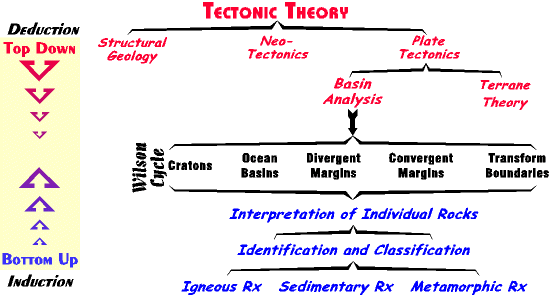INTRODUCTION TO WILSON CYCLES
Some Philosophy of Science
Some Philosophy of Science
The supercontinent cycle maps out the large scale history of the earth, the formation and fragmentation of the continents, within an overall evolutionary enlargement of the total size of the continents with each cycle.
But, this is just description. It does not tell us the processes by which individual igneous, sedimentary, and metamorphic rocks form within the cycle, or why these rocks are found in specific places, but not others. What we need is a model that bridges the gap between the nitty-gritty study of individual rocks, and the grand theories that are plate tectonics. To bridge this gap, though, we need to understand the difference between Bottom-up and Top-down.
Bottom-Up
We can look at it this way. Science begins with the study of individual phenomena - in the case of geology, minerals and rocks. We have to learn to observe, name, and classify each and every mineral and rock. We also have to learn the processes by which each mineral and rock forms. But, if this is all we did with minerals and rocks there would not be much use in studying them. We study rocks to understand the earth.
So, from the study of our individual rocks we begin to build theories about what all these rocks mean, how they are related - to each other, and to the earth as a whole. The facts of science.
We do this by induction. That is, we build our theories from the Bottom-Up by logically piecing together all the thousands of individual pieces (minerals and rocks) of the puzzle, until a theory of the earth's structure emerges. In the diagram below it has built up to the six tectonic regimes that compose the lithosphere of the earth.

Top-Down
Once we have a theory, of course, the theory becomes a powerful tool for understanding other parts of the earth. The theory tells us how everything is related by deductive logic to everything else. The theory also makes predictions about things we have not yet observed that would logically follow if the theory is true.
In the diagram below plate tectonic theory explains how the six tectonic regimes are logically related to each other and other parts of tectonic theory through the earth processes encompassed by the theory.

(Tectonics is the term used to refer to earth movements, and the structures that result. It includes plate tectonic theory, but also other subjects such as structural geology and neo-tectonics [the study of the effects of contemporary earthquakes, etc.] Likewise plate tectonic theory has various subdivisions that deal with specific subjects in the theory, including basin analysis, which is the study of the specific conditions under which recognizable suites of igneous, sedimentary, and metamorphic rocks form. For example, divergent boundaries are where the ophiolite suite [oceanic lithosphere] is generated.)
In practice, science oscillates back and forth between Top-Down and Bottom-Up strategies, each one being used to test the validity of the other. Newly discovered facts must naturally fit into the theory, and the theory must predict the existence of new facts that are true when we go out into the world to find them.
Thus, the complete diagram below shows how we can begin Top-Down or Bottom-Up and get to the same conclusions. Note that they come together in the Wilson Cycle where the six tectonic regimes of the lithosphere can be said to have been constructed inductively from observation, or to exist logically through plate tectonic theory.

Just because we have a theory does not mean it is the truth, of course. History is filled with abandoned theories. The fact that theories are vulnerable, and can be destroyed by ugly facts, is the fact that prior to 1968 virtually every geologist in the world was convinced that the continents were fixed in their current positions - had never, ever moved . No supercontinent cycles, no plate tectonics. The new facts being discovered at the time spoke otherwise, and argued that the fixidist view of the earth was incorrect.
Still, plate tectonic theory as presented in these pages is only a top-down description. We still have to bridge the gap from the theory to the study of individual minerals and rocks, and bring the two together into a model that allows us to switch back and forth between the Bottom-Up and the Top-Down.
At this point, of course, having introduced theories of the earth, we have to take our students into the laboratory and teach them minerals and rocks - Bottom-Up. But, assuming this studying has already been done, we go to the Wilson cycle.
The Wilson Cycle
The Wilson cycle is named after J. Tuzo Wilson who first made the connection between sea-floor spreading and subduction zones. The Wilson cycle takes all the complex, multidimensional processes operating in a supercontinent cycle and models them as the opening and closing of a single ocean basin.The Wilson cycle brings together all the processes of plate tectonics, and all the processes by which individual rocks are generated, and uses them to tell a plausible story of how plate tectonic theory and individual minerals and rocks are related.
The Wilson cycle is another web site, and can be accessed in two ways. The first is a one page version that summarized how the cycle works. The second is a nine stage version.
The nine stage version requires a good understanding of igneous, sedimentary, and metamorphic rocks, as well as plate tectonic processes, but is a powerful tool that makes everything about the earth make sense - Top-Down, and Bottom-Up. If you return to it over and over it will be a good measure of your growing knowledge and understanding.
Go On To:
OR, Go To: